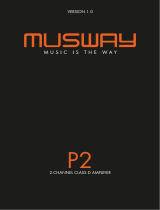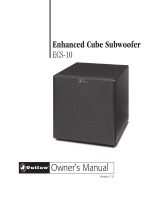
7
ENGLISH
INPUT SECTION
The XD800/8v2’s input section allows
you to send signals to the amplifier
section through the use of two, four or
eight differential-balanced inputs.
Input connections are via four pairs of
traditional RCA-type jacks.
+12 VDC Ground Remote
Remote
Level
Control
CH. 5
(
L
)
CH. 6
(
R
)
CH. 3
(
L
)
CH. 4
(
R
)
CH. 1
(
L
)
CH. 2
(
R
)
Bridged
CH. 7
(
L
)
CH. 8
(
R
)
BridgedBridgedBridged
INPUT SECTION
(
L
)
(
R
)
CH. 1&2 CH. 3&4 CH. 5&6 CH. 7&8
Remote
Level
Mode
All
|
5- 8
|
7&8
Input Mode
2 Ch.
|
4 Ch.
|
8 Ch.
CH. 7
(
L
)
CH. 8
(
R
)
CH. 7 & 8
Filter Mode
Filter Freq. (Hz)
Input
Sens.
O
|
HP
|
LP
CH. 5
(
L
)
CH. 6
(
R
)
CH. 3
(
L
)
CH. 4
(
R
)
CH. 1
(
L
)
CH. 1 & 2
CH. 3 & 4 CH. 5 & 6
CH. 2
(
R
)
Filter Mode
Input
Sens.
O
|
HP
|
LP
Filter Mode
Filter Freq. (Hz)
Input
Sens.
O
|
HP
|
LP
Filter Mode
Filter Freq. (Hz)
Input
Sens.
O
|
HP
|
LP
CH. 1
CH. 2
CH. 3
CH. 4
CH. 5
CH. 6
(
L
)
(
R
)
CH. 7
CH. 8
INPUT SECTION
+12 VDC Ground Remote
8 Channel Amplifier
Turn-On
Mode
Rem.
|
Oset
|
Signal
Input Voltage
Low
|
High
2 Ch. Input 1 feeds CH. 1, CH. 3, CH. 5 & CH. 7
Input 2 feeds CH. 2, CH. 4, CH. 6 & CH. 8
4 Ch. Input 1 feeds CH. 1 & CH. 3
Input 2 feeds CH. 2 & CH. 4
Input 5 feeds CH. 5 & CH. 7
Input 6 feeds CH. 6 & CH. 8
8 Ch. Each input feeds its
corresponding output channel
INPUT MODES:
If you wish to send eight discrete channels into
the XD800/8v2, simply use all eight inputs and set
the “Input Mode” switch in the “8 Ch.” position.
If you wish to feed all eight channels by using
only four channels of input, set the “Input Mode”
switch to “4 Ch.” and use only the inputs to
channels 1, 2, 5 and 6. In this mode, input 1 will
feed channels 1 and 3, input 2 will feed channels
2 and 4, input 5 will feed channels 5 and 7 and
input 6 will feed channels 6 and 8.
If you wish to use only two channels of input
to deliver signal to all eight amplifier channels,
set the “Input Mode” switch to “2 Ch.” and
use only the inputs to channels 1 and 2. In this
mode, input 1 will feed all the odd-numbered
channels (1, 3, 5 and 7) and input 2 will feed all
the even-numbered channels (2, 4, 6 and 8).
Remote
Level
Mode
All
|
5- 8
|
7&8
Input Mode
2 Ch.
|
4 Ch.
|
8 Ch.
CH. 7
(
L
)
CH. 8
(
R
)
CH. 7 & 8
Filter Mode
Filter Freq. (Hz)
Input
Sens.
O
|
HP
|
LP
CH. 5
(
L
)
CH. 6
(
R
)
CH. 3
(
L
)
CH. 4
(
R
)
CH. 1
(
L
)
CH. 1 & 2 CH. 3 & 4 CH. 5 & 6
CH. 2
(
R
)
Filter Mode
Filter Freq. (Hz)
Input
Sens.
O
|
HP
|
LP
Filter Mode
Filter Freq. (Hz)
Input
Sens.
O
|
HP
|
LP
Filter Mode
Filter Freq. (Hz)
Input
Sens.
O
|
HP
|
LP
CH. 1
CH. 2
CH. 3
CH. 4
CH. 5
CH. 6
(
L
)
(
R
)
CH. 7
CH. 8
INPUT SECTION
+12 VDC Ground Remote
8 Channel Amplifier
Turn-On
Mode
Rem.
|
Oset
|
Signal
Input Voltage
Low
|
High
2 Ch. Input 1 feeds CH. 1, CH. 3, CH. 5 & CH. 7
Input 2 feeds CH. 2, CH. 4, CH. 6 & CH. 8
4 Ch. Input 1 feeds CH. 1 & CH. 3
Input 2 feeds CH. 2 & CH. 4
Input 5 feeds CH. 5 & CH. 7
Input 6 feeds CH. 6 & CH. 8
8 Ch. Each input feeds its
corresponding output channel
INPUT MODES:
Status
LED
(pg. 11)
Ch. 1 & 2 Filter
Frequency
Selector
(pg. 8)
Ch. 1 & 2
Filter Mode
Selection
(pg. 8)
Ch. 1 & 2 Input
Sensitivity Control
(pg. 8)
Ch. 3 & 4 Filter
Frequency
Selector
(pg. 8)
Ch. 3 & 4
Filter Mode
Selection
(pg. 8)
Ch. 3 & 4 Input
Sensitivity Control
(pg. 8)
Ch. 5 & 6 Filter
Frequency
Selector
(pg. 8)
Ch. 5 & 6
Filter Mode
Selection
(pg. 8)
Ch. 5 & 6 Input
Sensitivity Control
(pg. 8)
Ch. 7 & 8 Filter
Frequency
Selector
(pg. 8)
Ch. 7 & 8
Filter Mode
Selection
(pg. 8)
Ch. 7 & 8 Input
Sensitivity Control
(pg. 7)
Remote
Level Mode
Switch
(pg. 9)
Input
Mode
Switch
(pg. 7)
Input
Voltage
(pg. 7)
Turn-On
Mode
(pg. 6)
Input Voltage Range:
Input Voltage Range: A wide range of signal
input voltages can be accommodated by the
XD800/8v2’s input section (200mV – 8V). This
wide range is split up into two sub-ranges,
accessible via the “Input Voltage” switch:
“Low”: for preamp level signals
“High”: for speaker level signals
Remote
Level
Mode
All
|
5- 8
|
7&8
Input Mode
2 Ch.
|
4 Ch.
|
8 Ch.
CH. 7
(
L
)
CH. 8
(
R
)
CH. 7 & 8
Filter Mode
Filter Freq. (Hz)
Input
Sens.
O
|
HP
|
LP
CH. 5
(
L
)
CH. 6
(
R
)
CH. 3
(
L
)
CH. 4
(
R
)
CH. 1
(
L
)
CH. 1 & 2 CH. 3 & 4 CH. 5 & 6
CH. 2
(
R
)
Filter Mode
Filter Freq. (Hz)
Input
Sens.
O
|
HP
|
LP
Filter Mode
Filter Freq. (Hz)
Input
Sens.
O
|
HP
|
LP
Filter Mode
Filter Freq. (Hz)
Input
Sens.
O
|
HP
|
LP
CH. 1
CH. 3
CH. 5
(
L
)
CH. 7
CH. 8
INPUT SECTION
+12 VDC Ground Remote
8 Channel Amplifier
Turn-On
Mode
Rem.
|
Oset
|
Signal
Input Voltage
Low
|
High
2 Ch. Input 1 feeds CH. 1, CH. 3, CH. 5 & CH. 7
Input 2 feeds CH. 2, CH. 4, CH. 6 & CH. 8
4 Ch. Input 1 feeds CH. 1 & CH. 3
Input 2 feeds CH. 2 & CH. 4
Input 5 feeds CH. 5 & CH. 7
Input 6 feeds CH. 6 & CH. 8
8 Ch. Each input feeds its
corresponding output channel
INPUT MODES:
The “Low” position on the “Input Voltage”
switch selects an input sensitivity range between
200mV and 2V for all input channels. This means
that the “Input Sens.” rotary control for each
channel section will operate within that voltage
window. If you are using an aftermarket source
unit, with conventional preamp-level outputs, this
is most likely the position that you will use
The “High” position on the “Input Voltage”
switch selects an input sensitivity range between
800mV and 8V for all input channels. This is
useful for certain high-output preamp level
signals as well as speaker-level output from source
units and small amplifiers. To use speaker-level
sources, splice the speaker output wires of the
source unit or small amplifier onto a pair of RCA
cables or plugs or use the JL Audio ECS Speaker
Wire to RCA adaptor (XD-CLRAIC2-SW).
Line Output Converters are usually not needed
with the XD800/8v2. If you find that the output
cannot be reduced sufficiently with a direct
speaker level signal applied to the amplifier and
the “Input Voltage” switch in its “High” pos i tion,
you may use a “line output converter” or voltage
divider to reduce the signal level.
























